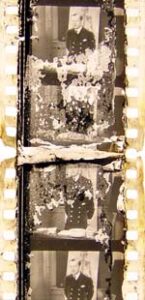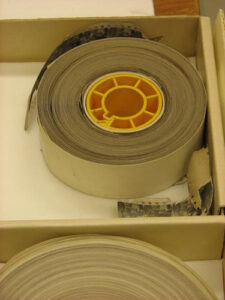Who knew the Library of Congress has a robotic system for the automated digitization of VHS and 3/4″ Umatic videocassettes? I sure didn’t, but I’m glad I took a last-minute opportunity yesterday to learn about the LoC’s film and video digitization and preservation facilities and efforts as part of an event on the Northwestern campus (where I work) called Screen Cultures: A Symposium on Moving Image Collections and Historiography.

I was only able to attend one panel featuring NYU historian Dan Streible, organizer of the Orphan Film Symposium, and the LoC’s head of the Moving Image Section of the Motion Picture, Broadcasting, and Recorded Sound Division, Mike Mashon. Streible discussed how preserved and digitized film materials helped him research his book Fight Pictures: A History of Boxing and Early Cinema. He emphasized how having access to higher-quality and resolution copies reveals details that help construct a more accurate history. Streible also noted that the existence of multiple copies in different formats tells stories about the intended purpose and audience for a film. For instance a 16mm copy of what was originally 35mm film may indicate that it was distributed for small-venue or even home screenings.

I was reminded about the existence of paper prints of early motion pictures that were made prior to 1912 when copyright law didn’t cover movies. In effect, creating these prints was a way for early studios to hack the copyright system, since only works that could be fixed on paper could be copyrighted. Thus, studios submitted these huge rolls of paper contact prints of their films to the Library of Congress so they would enjoy copyright protection.
In his presentation Mike Mashon showed off the digitizing and preservation resources housed at the new Packard Campus of the National Audio-Visual Conservation Center in Culpepper, VA. There they have a specialized Kinetta Scanner (PDF: “Preserving Early Motion Picture History with the Kinetta Archival Scanner“) that digitizes the paper prints at a rate of 4 frames per second. Before this device was available, preservation and duplication had to be done by hand, photographing the prints frame-by-frame. Amazingly, the digitized paper prints can then be output back to optical film.
The LoC is digitizing all of their video and film assets using a lossless version of the Motion JPEG2000 codec. Unlike common video codecs like DV, AVCHD, H.264 and DVCProHD, the one the LoC is using throws away no image data, with only a moderate amount of lossless compression in order to shrink the data size. This means the LoC is retaining as much video quality as their digitizing equipment can capture, but it also means they’re storing a massive quantity of data. According to Mashon their data center is able to archive 8 petabytes on tape, with a copy on spinning discs for regular access.
In addition to the full quality MJPEG2000 files, the LoC is creating so-called “access” files for use by the public in MPEG2 (the same codec in DVDs). They’re moving to creating MPEG-4 files, which are more bandwidth efficient.
It was reassuring to learn that despite all this digitization the LoC plans on retaining and preserving original films, even ones on volatile nitrate stock, as long as they remain usable. However, when asked about retaining videotapes, Mashon acknowledged that space will become an issue and holding onto magnetic tape will be a lesser priority. One very practical reason for this is that videotape degrades more quickly than film or paper, often becoming unplayable in as little as twenty years.
The LoC makes digitized materials available for viewing in its reading room on Capitol Hill. I learned that members of the public can request materials to be digitized for viewing. If the material is in the public domain or licensed for distribution you can even take a copy home, provided you bring media suitable for copying it.
I can only imagine the cost of this enormous preservation effort, but I’m very glad that such investment is being made in retaining these valuable documents of our historical and cultural legacy.
Leave a Reply